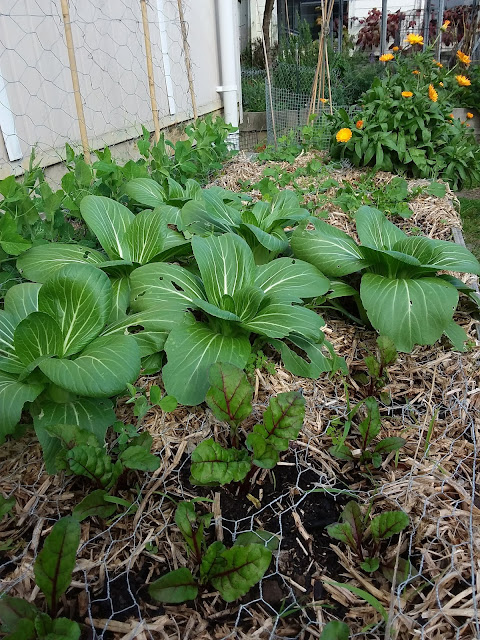Sun Survey
I've been trying to decide on the best place to start a veggie bed in the front garden. A few weeks ago I photographed the entire front garden different points in the day. Looking at that photo series, I zeroed in on a spot that seems to get the most sun. Next I did a sun survey for this chosen spot, just to confirm it was sunny enough, before building my raised bed. I had the boards laid out to mark the planned borders of the garden bed.
Here is what it looked like:
9am:
10am:
11:30
12:30:
2pm:
4pm:
5:30:
7:15:
The goal was to photograph once an hour from the first sunlight on the location to the last. I picked a sunny day with not much going on. In fact it was Chrismas day, which is pretty uneventful for us, as we celebrate Summer Solstice instead. As you can see, it did not all go to plan. Gaps sometimes stretched to an hour and a half, and at one point I was out visiting my parents and texted my partner asking him to snap a quick pic for me (the one at 4pm). My data gathering may have been imperfect, but it was enough information for me to draw some conclusions.
One corner looses the sun for a while in the morning. Another corner looses the sun around 5pm. Both of the shady corners still get 6 hours of full sun, plus some partially shadded sun in the evening. Afternoon shade can be decreased some by pruning a line of bushes along the south-west side (which really they need anyway). The rest of the garden bed gets even more sun - about 8 hours plus some partial sunshine in the evening. I decided that this was a decent spot to build my brand new garden bed.
A sun survey is an excellent way to identify promising spots for veggie gardening. In a lot of cases, you can just pick a sunny day and write down what time the sun first hits, and what time the sun has left the spot. This is the first time I've done it with photos but I had a location with complex sun patterns. Between the lines of the house and various bushes, the sun was hitting different spots at different times of day. I had a spot in mind that seemed ideal upon casual observation, but turned out to be the worst once I studied the photos and did added up daylight hours. And then there is the simple fact that the sunlight is always changing. The front garden is on the South-West side of the house, and as such, it will get much less sunlight in Winter. I'm resigned to the fact that this might be a very shadded garden bed in Winter. I'm okay with this as long as it does well in Summer. There are things that will grow in shady conditions, even if it's just ground cover that will improve the soil over Winter so it's in good shape come Spring. Let's just say I'm not planting any perennials in this bed anytime soon.
Here is what it looked like:
9am:
10am:
11:30
12:30:
2pm:
4pm:
5:30:
7:15:
The goal was to photograph once an hour from the first sunlight on the location to the last. I picked a sunny day with not much going on. In fact it was Chrismas day, which is pretty uneventful for us, as we celebrate Summer Solstice instead. As you can see, it did not all go to plan. Gaps sometimes stretched to an hour and a half, and at one point I was out visiting my parents and texted my partner asking him to snap a quick pic for me (the one at 4pm). My data gathering may have been imperfect, but it was enough information for me to draw some conclusions.
One corner looses the sun for a while in the morning. Another corner looses the sun around 5pm. Both of the shady corners still get 6 hours of full sun, plus some partially shadded sun in the evening. Afternoon shade can be decreased some by pruning a line of bushes along the south-west side (which really they need anyway). The rest of the garden bed gets even more sun - about 8 hours plus some partial sunshine in the evening. I decided that this was a decent spot to build my brand new garden bed.
A sun survey is an excellent way to identify promising spots for veggie gardening. In a lot of cases, you can just pick a sunny day and write down what time the sun first hits, and what time the sun has left the spot. This is the first time I've done it with photos but I had a location with complex sun patterns. Between the lines of the house and various bushes, the sun was hitting different spots at different times of day. I had a spot in mind that seemed ideal upon casual observation, but turned out to be the worst once I studied the photos and did added up daylight hours. And then there is the simple fact that the sunlight is always changing. The front garden is on the South-West side of the house, and as such, it will get much less sunlight in Winter. I'm resigned to the fact that this might be a very shadded garden bed in Winter. I'm okay with this as long as it does well in Summer. There are things that will grow in shady conditions, even if it's just ground cover that will improve the soil over Winter so it's in good shape come Spring. Let's just say I'm not planting any perennials in this bed anytime soon.










Comments
Post a Comment